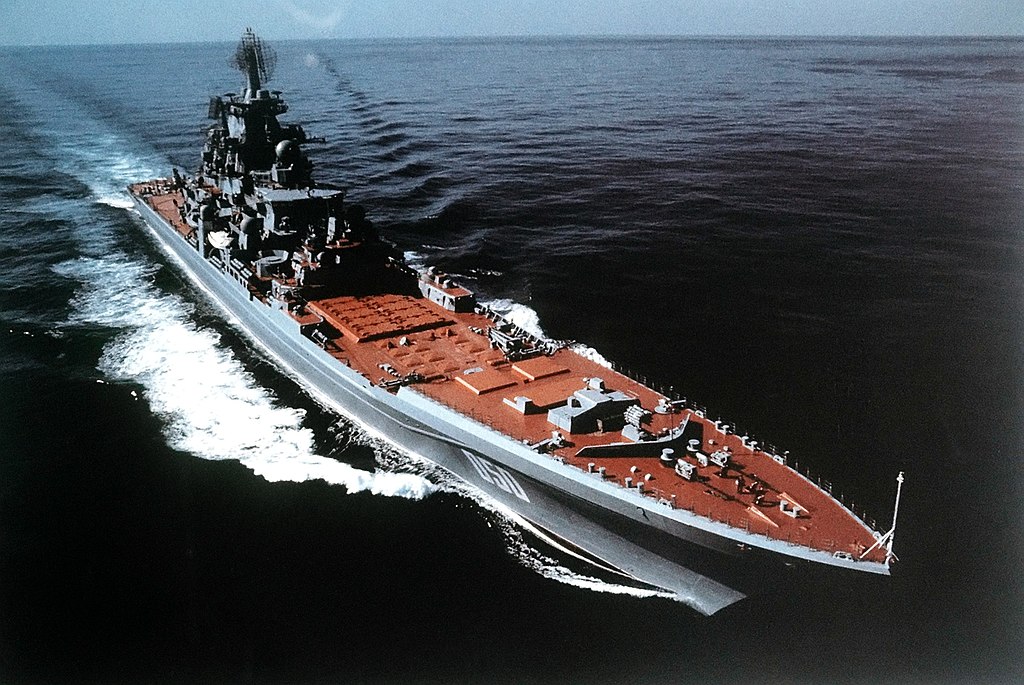The Russian Navy will not modernize the massive Pyotr Veliky battle-cruiser, the world’s only nuclear-powered surface vessel, and the largest non-aircraft carrier naval warship.
US Military Base In Japan Nears Closure; Tokyo To Relocate Okinawa Facility After 10 Years Of Delay
The one-of-kind warship that packs phenomenal firepower was supposed to be refitted and modernized after another ship in its class, Admiral Nakhimov, concluded her modernization. Pyotr Veliky will head for decommissioning following that.
According to reports, the anticipated refurbishment has been canceled owing to concerns over the massive costs and technical challenges involved in the vessels’ operations and maintenance.
Moreover, the ships are also not in harmony with newer concepts being considered in the Russian Navy, which favor mid-sized, heavily armed missile boats, corvettes, and frigates, which have a mix of land-attack, surface-ship strike, anti-air, and submarine hunting capabilities.
This does not, however, question the large Soviet-era Kirov-class ships’ military efficacy. The gigantic vessels, with their staggeringly large arsenal, can provide a fleet with effective anti-land, anti-ship, air defense, and anti-submarine warfare (ASW) cover while sailing for extended periods of time, owing to the nearly unlimited power generated by the nuclear reactors.
Pyotr Veliky To Be Retired
Quoting officials, a report in Defense Security Asia said, “The monster warship is slated for decommissioning, leaving only one active Kirov Class vessel in the Russian fleet.” Meanwhile, Admiral Nakhimov is set to finish modernization and rejoin Russia’s Northern Fleet by 2024-25, making it the sole remaining battle-cruiser.
According to Navy Recognition, the modernization will add “10 versatile shipborne launchers, capable of carrying eight Kalibr-NK and/or Oniks cruise missiles, and eventually, it is expected to be equipped with the Tsirkon hypersonic missiles.”

It will be deployed in the Arctic region, which has emerged as a significant geopolitical and commercial area of contention between Russia and US-Europe. The Kirov-class is “comparable” to Japan’s Izumo-class Landing Helicopter Dock (LHD) ships while “boasting a weight exceeding triple that of the US Navy’s Arleigh Burke-class destroyers.”
Initially, both the Pyotr Veliky and Admiral Nakhimov were planned to be modernized with “cutting-edge sensors, electronics, and weaponry.” But the Pyotr Veliky’s “fate shifted.”
The ship and its operational philosophy were not in harmony with the Soviet and Cold War-era need to have large destroyers and cruisers. “The decision reflects a broader trend in Russia’s naval strategy, emphasizing smaller frigates and corvettes over larger destroyer or cruiser-sized ships since the Soviet era,” DSA said.
The introduction of missiles like the Zircon hypersonic anti-ship missile and the Kalibr also reduced the overall need to have large, heavily armed surface combatants. “(These) missiles enable Russian ships to engage targets effectively from coastal waters.”
Remaining Kirov-Class Battle-cruiser To Patrol ‘Next Flashpoint’ Arctic
The remaining Kirov Class battle-cruiser is expected to serve under the Northern Fleet, reflecting Russia’s “heightened focus on the Arctic region as a key trade route and geopolitical battleground.”
This Russian leadership, too has officially recognized the Arctic as a future flashpoint with the West. Russia’s Chief of General Staff, General Valery Gerasimov, during a briefing of foreign military attaches of the RuMoD’s activity on December 21, said the “United States and NATO and focused on ensuring their dominance in the Arctic and deterring the Russian Federation in the region.”
While the “territories of Finland and Sweden are increasingly being used for the deployment of NATO troops and their operational build-up in areas bordering Russia,” Moscow has responded with military activities like “systematically developing groupings of forces in the Arctic (and) creating and modernizing the necessary infrastructure.”
These military activities in the “Arctic (are not oriented towards) the demonstration of military force but to ensuring the security of economic development, including navigation in the Northern Sea Route and the implementation of projects in the area of exploration and extraction of natural resources.”
Sergey Shoigu
Russia’s Big, Giant Warships
The Kirov-class battleships do “offer superior endurance (and) extended sea deployments when resupplied by air,” but it appears that Russia does not believe a permanent fixture in the sea is really a massive advantage since the task can now be achieved by maritime patrol aircraft, satellites, and their respective sensors.
Moreover, Russia already employs nuclear-powered icebreakers for the Arctic that serve semi-diplomatic and territorial assertion roles, apart from their resource exploration purpose. But the fact that Admiral Nakhimov is being “refurbished” means Russia still finds some value in the concept and the importance of naval strength.
For instance, besides new “sensors” and “electronics,” the Nakhimov is also armed with the naval version of the S-400 air defense system.
Thus, retiring the Kirov Class cruisers may be influenced by a combination of factors like the high cost of modernization, the operational expenses of nuclear-powered ships, and the technological and tactical obsolescence of certain military concepts.
- The author can be reached at satamp@gmail.com
- Follow EurAsian Times on Google News